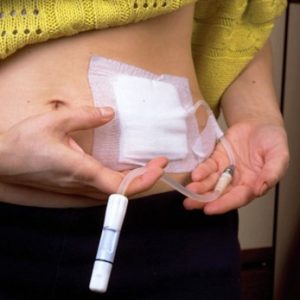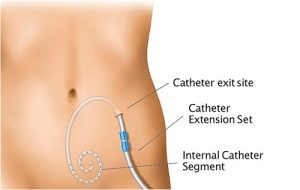What is a peritoneal dialysis (PD) catheter?
In this article, we will describe what is a peritoneal dialysis (PD) catheter.
A PD catheter is a soft, thin tube (catheter) which is placed through your tummy and into the peritoneum – to enable peritoneal dialysis to happen. It is about 30 cm (12 in) long and as wide as a pencil.
The tube carries cleansing (dialysis) fluid in and out of your abdomen. The inner lining of the abdomen, known as the peritoneum, acts as a filter and removes wastes from blood and puts them in the dialysis fluid.
It is also called a Tenckhoff catheter; named after Dr Henry Tenckhoff, the pioneering American nephrologist who developed it originally.
How is a PD catheter inserted?
About two weeks before you start peritoneal dialysis, you will have a minor surgical operation. A doctor inserts the catheter through your tummy and into the peritoneum. This is done either when you are asleep (general anaesthetic) or awake (local anaesthetic, i.e. painkiller injected).
Note. If you take warfarin, aspirin, clopidogrel, apixaban or any other blood-thinning tablets, you will need to stop taking these before the procedure is carried out. Your doctor or pre-operative assessment clinic nurse (or PD nurse) will advise exactly when to stop taking these tablets.
After two weeks you will attend the hospital daily for 2-3 days to be trained to do the dialysis yourself. This catheter stays in place permanently.

PD catheter

Half the catheter is inside the body and is a spiral shape. The other half the catheter is outside the body.
Complications
There are four main complications of PD catheter insertion.
- Functional problems. In less than 1o% of cases, the catheter may not work despite apparently successful insertion. This may be due to the tip of the catheter sitting in the wrong place, or getting covered by internal tissue, which stops it working. You may need a second operation so it can be repositioned
- Bleeding. Bleeding may occur. This usually shows itself as bruising around the wound, and it usually stops of its own accord. Occasionally more surgery is needed to stop the bleeding
- Infection. You will be given intravenous antibiotics at the time of the catheter insertion to prevent infection. Despite this, some patients develop infection at the catheter exit site, which requires treatment with a further course of antibiotics. Very occasionally this may require the catheter to be removed
- Bowel perforation. In less than 1% of patients, the bowel is cut by mistake. This is a serious complication that may require a surgical operation and an inpatient stay in hospital.
PD catheter survival
Like AV fistulas, PD catheters do not always last forever.
In a US study the average survival of a PD catheter was 18 months (Haught, 2020). Whereas the average lifespan of a fistula is 3 years (2 years if you have diabetes) (Yolgösteren, 2018).
In a Spanish study of 146 patients (Rodrigues, 2023), removal of the catheter was required in 49 patients (34%). Of these, in 29 patients (59%), the cause of catheter removal was infection (peritonitis in 28 patients and a tunnel infection in 1). PD catheter survival rates over 12, 24 and 36 months were 80%, 72% and 62%, respectively.
Summary
We have described what is a peritoneal dialysis (PD) catheter. We hope it has been helpful.
Other resources
What is peritoneal dialysis?
PD catheter insertion patient information (Bristol)
PD catheter insertion patient information (Coventry)
Last Reviewed on 17 May 2024
